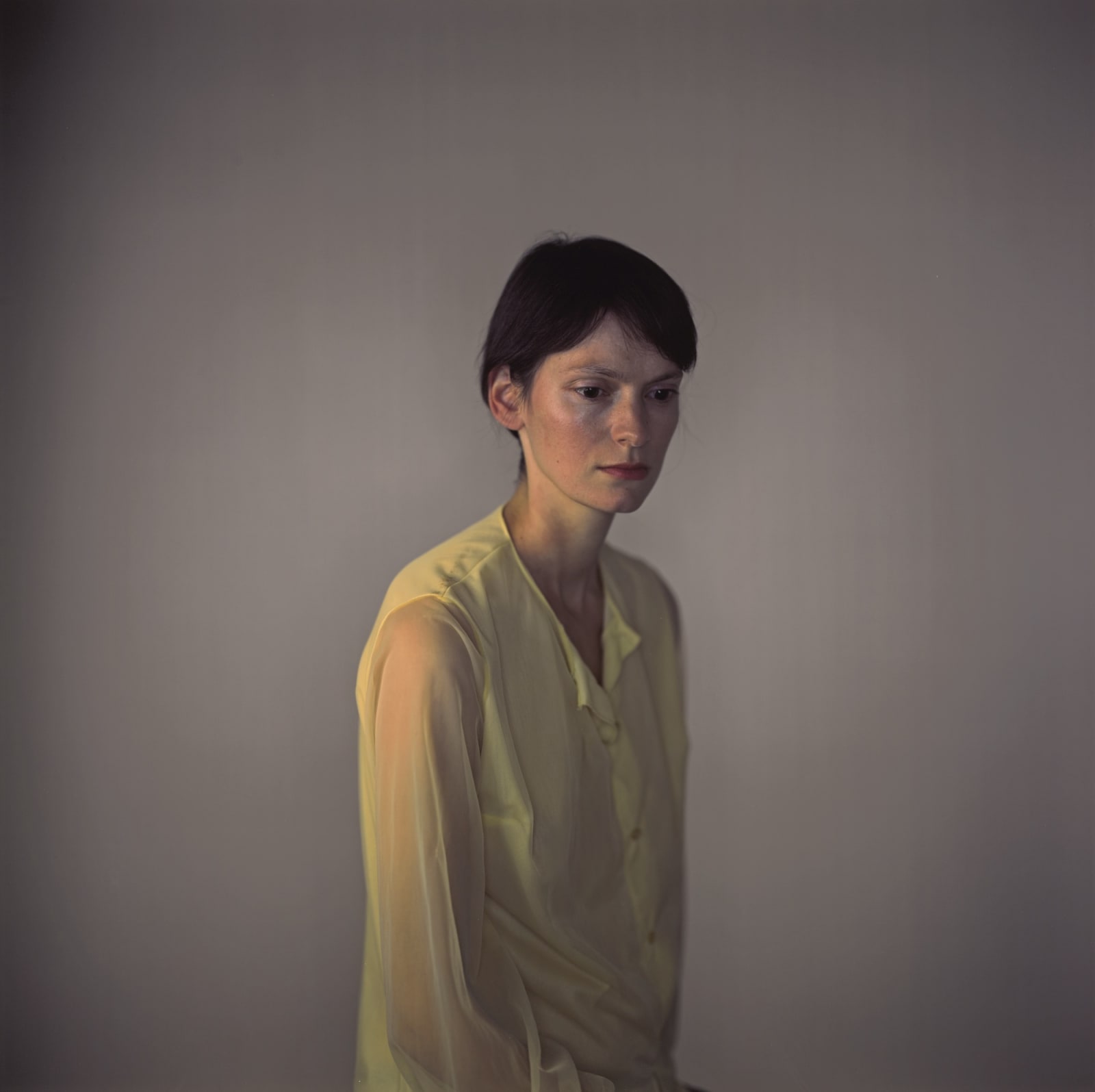Richard Learoyd British, b. 1966
Olya in Yellow, Two, 2010
unique Ilfochrome photograph, flush-mounted onto aluminium
48 x 48 inches
121.9 x 121.9 cm
121.9 x 121.9 cm
signed in black felt tip pen verso and with a gallery label bearing information about the work in facsimile affixed to the back of the frame
Richard Learoyd’s unique photographs need to be experienced firsthand to be fully understood. While numerous contemporary artists have shown large-scale photographic prints in galleries, Learoyd’s self-devised process achieves a new...
Richard Learoyd’s unique photographs need to be experienced firsthand to be fully understood. While numerous contemporary artists have shown large-scale photographic prints in galleries, Learoyd’s self-devised process achieves a new and captivating level of detail in which every eyelash, every freckle and mottled patch of skin is seen and felt. Consequently, the subjects of his photographs appear ‘more alive, more beautiful and more fallible – even more vulnerable – than the people we see in most pictures’.1
Learoyd first set up a large camera obscura within his commercial studio in 2003. To make a picture, his models sit in an adjoining space against a white wall and their image is projected through a huge, 750 mm lens into this darkened room. An exposure is made, using flash, onto a sheet of positive paper inside the room, which is then processed and dried in situ, a full-size negativeless image emerging 18 minutes later. The extended length of a sitting, which might run over two days, is closer to the experience of sitting for a painted portrait than a typical studio session and, as such, his models sometimes fall into ‘a meditative and introspective state’ as the process continues.2 As in all photography, a wide aperture produces a shallow depth of field, so in these images, there is often no more than 5mm in sharp focus. Learoyd has reflected on what he feels this communicates: ‘For me, in my work, the implication or meaning of this shift between extreme sharpness and blur is an emerging and submerging of a person’s consciousness, and emphasis of their immediate presence.’ 3
Learoyd photographs acquaintances rather than friends, paying his sitters in recognition of the long time they are needed to make a single picture. Olya was introduced to the artist through another model and she features in several other photographs including the first Olya in Yellow, 2010; Olya Square Mirror, 2010, in which she is dressed all in black, and Olya and Annie, 2011, where she is shown clutching her baby. Learoyd often picks up clothes for his models from street markets close to his studio. He selects purposely unspecific, slightly unfashionable clothes, and sheer textures, which photograph well against the skin. The delicate yellow blouse that Olya wears in this picture crops up a few years later in Melanie, 2015, while the artist’s ongoing fascination with translucency is evident in his recent studies of paper-thin flowers.
1 Sandra S.Phillips (intro), Richard Learoyd, Fundación Mapfre, Madrid/Fraenkel Gallery, San Francisco, 2019, p9
2 Ibid, p17
3 Learoyd quoted in ‘Flesh and Bone: Unique Photographs by Richard Learoyd’, Aperture, no.199, Summer 2010
Learoyd first set up a large camera obscura within his commercial studio in 2003. To make a picture, his models sit in an adjoining space against a white wall and their image is projected through a huge, 750 mm lens into this darkened room. An exposure is made, using flash, onto a sheet of positive paper inside the room, which is then processed and dried in situ, a full-size negativeless image emerging 18 minutes later. The extended length of a sitting, which might run over two days, is closer to the experience of sitting for a painted portrait than a typical studio session and, as such, his models sometimes fall into ‘a meditative and introspective state’ as the process continues.2 As in all photography, a wide aperture produces a shallow depth of field, so in these images, there is often no more than 5mm in sharp focus. Learoyd has reflected on what he feels this communicates: ‘For me, in my work, the implication or meaning of this shift between extreme sharpness and blur is an emerging and submerging of a person’s consciousness, and emphasis of their immediate presence.’ 3
Learoyd photographs acquaintances rather than friends, paying his sitters in recognition of the long time they are needed to make a single picture. Olya was introduced to the artist through another model and she features in several other photographs including the first Olya in Yellow, 2010; Olya Square Mirror, 2010, in which she is dressed all in black, and Olya and Annie, 2011, where she is shown clutching her baby. Learoyd often picks up clothes for his models from street markets close to his studio. He selects purposely unspecific, slightly unfashionable clothes, and sheer textures, which photograph well against the skin. The delicate yellow blouse that Olya wears in this picture crops up a few years later in Melanie, 2015, while the artist’s ongoing fascination with translucency is evident in his recent studies of paper-thin flowers.
1 Sandra S.Phillips (intro), Richard Learoyd, Fundación Mapfre, Madrid/Fraenkel Gallery, San Francisco, 2019, p9
2 Ibid, p17
3 Learoyd quoted in ‘Flesh and Bone: Unique Photographs by Richard Learoyd’, Aperture, no.199, Summer 2010
Provenance
Private Collection, UKExhibitions
Barcelona, Casa Garrga Nogués, Fundación Mapfre, Richard Learoyd, 5 June - 8 September 2019, touring to:The Hague, Fotomuseum Den Haag, 5 October 2019 - 5 January 2020
Madrid, Fundación Mapfre, 19 February - 24 May 2020
Literature
Sandra S. Phillips, Philip Gefter, Richard Learoyd, Fundación Mapfre, Madrid / Fraenkel Gallery, San Francisco, 2019, p242, the first version of Olya in Yellow, 2010, illustrated p195Join our mailing list
* denotes required fields
We will process the personal data you have supplied to communicate with you in accordance with our Privacy Policy. You can unsubscribe or change your preferences at any time by clicking the link in our emails.
